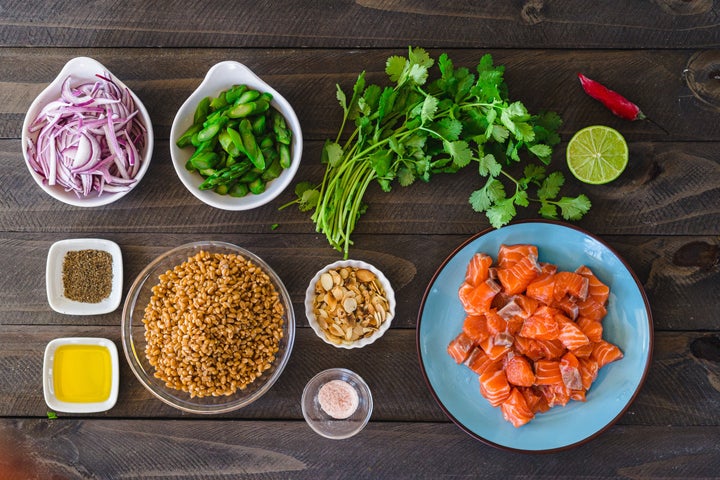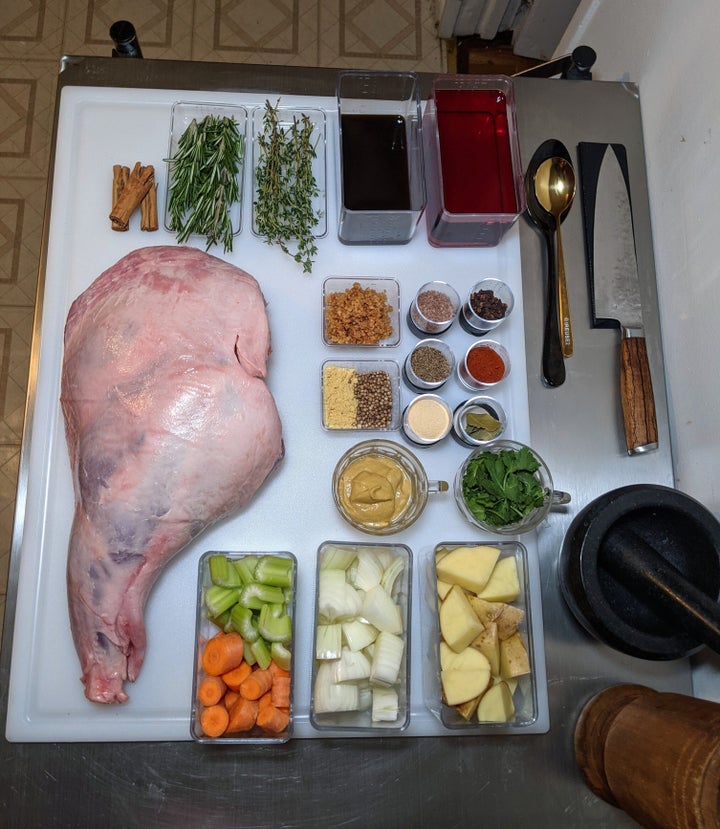
During what has been a tremendously stressful year, many of us have retreated to our kitchens, finding sanctuary in moving, in doing and in the satisfaction of producing tangible results. After all, #quarantinebaking isn’t a “thing” just because it yields pops of pleasure in the form of taste ― it has mental health benefits, too.
However, there are many of us who still see the kitchen as a fiery den of potential panic. Cooking with anything but the simplest ingredients can seem daunting at the end of an exhausting day, prepping can feel overwhelming, and whatever do you mean by “fold in the cheese?!”
Well, take a deep breath. We’re here to break down the practice of mise en place and change your kitchen approach forever.
What is mise en place?
Ever wonder what makes cooking shows go so smoothly, where all the ingredients are already neatly chopped, measured out and in little glass bowls? That, in a nutshell, is mise en place ― such a simple kitchen hack that Steven Del Lima, executive chef and owner of Hooks & Chops in Commack, New York, wagers that, “Chances are, you’ve probably used this method of cooking before but just weren’t aware of the term associated with it!”
Pronounced “MEEZ ahn plahs,” it’s French for “putting into place” and a practice that dates back to the late 1800s. It’s a technique used by cooks in professional kitchens and restaurants, and it’s one of the first things they teach you in cooking classes.
“Setting up mise en place at home sounds fancy and difficult, but it’s just about being organized so that once you start cooking, it’s smooth sailing,” vouches Alicia Kennedy, prominent food writer and vegan baker.
Richard Robertson V, a private chef for Double R Catering LLC, on Long Island, New York, breaks it down in simple terms: “It’s all about having everything you need for your recipe out ― washed, chopped and otherwise prepped, properly measured, in their places and ready to go.” And with that, you are, too.
Why we mise
There are a lot of practical reasons to organize your ingredients in this way. The first, as Robertson says, is so that “once you start cooking, you don’t have to stop.” It streamlines the whole process to be able to seamlessly toss things in in ready sequence. “Timing is everything in the kitchen, so being neat and prepared is very important,” Robertson said.
“You don’t want to be sautéeing garlic, then have to chop up an onion,” he explains. “By the time you do that, your garlic burns, your recipe is ruined and you have to start over. That’s why I’ve never forgotten the five Ps I was taught by a chef: ‘proper preparation prevents poor performance.’”
And, Robertson assures, “you’ll look just like the chefs you see on TV!” Because sometimes a little swagger is all you need to feel more like you can handle the heat in the kitchen. That perception of yourself might be just what you need to “start feeling like you’re doing the right thing.”
In fact, this is where some chefs start. Executive chef Maria Grubb of Underground Dining Club and ― until COVID-19 forced its closure ― renowned Gallo Negro in San Juan, Puerto Rico, reminisces, “It reminds me of being a kid and watching local chefs on the 12 o’clock cooking segment during summertime … all those clear ramekins with ingredients going into mixing bowls and pots made me smile.”
Setting up to soothe
Not only does having a proper mise en place set you up for success, it also sets you up for a relaxing cooking experience. Going through its motions can alleviate stress in and of itself, and provide rituals and benefits that can ease a troubled mind.
“Putting a check mark next to ‘chop carrots’ or ‘toast spices’ and knowing you won’t have to run around looking for stuff feels great,” Grubb says with enthusiasm. “Having all those ingredients ready to cook in a delicious recipe and feeling that you’re ready to rock service is always a moment of Zen ― and in this new era, even Instagram pic-worthy” to have a neat, satisfying spread of ingredients rounded up before the rodeo begins.
According to Grace Dickman, a licensed clinical social worker, psychotherapist and founder of Illinois-based practice Real Therapy, in addition to the act of prepping and the visual of readiness creating calm, “mise en place provides the opportunity to practice ‘informal,’ or everyday, mindfulness.” That falls right in line with Del Lima’s assertion that “mise en place is also a principle of discipline and organization.” All these are crucial coping skills for all types of anxiety.
“When my clients are feeling highly anxious, I guide them through grounding exercises that connect them with tangible objects in their environment, shifting attention away from the chaos in their head and toward the details in their physical space,” Dickman explains. But most importantly, “by cleaning, cutting, measuring and organizing ingredients, you can engage in all five senses to mindfully interact with each component of a meal. For example, you can feel the water flow over your hands as you wash produce, listen to the sound of your knife chopping, smell the aroma of fresh herbs, taste the zing of citrus and then see the full array of ingredients laid out in their respective bowls,” she adds.

Pro tips for mise en place
The benefits of getting all of your ducks in a row before you cook them are clearly many. But how to do it? Insight and tips from chefs can help even the most uncertain cooks feel like the kitchen is your natural domain:
Set up your prep space. New York private chef and caterer Robert Springer recommends you “always have a place free of appliances and clutter to set up your mise en place and prep station.” This includes your cutting board area, which he advises should be on a flat surface and include a “wet paper towel underneath to set it firmly in place” for additional safety.
Have your recipe ready and develop a plan. Grubb likes to read through the recipe twice with her staff to “see what you need, then write a list of ingredients” so it feels familiar for easier mental processing and actual execution. The more comfortable you are with what’s next, the less apt you’ll be to sweat it.
Gather everything you need. That doesn’t just mean your raw food ingredients, Del Lima points out. “This includes all of your cooking equipment ― pans, utensils, everything,” Robertson reinforces. Springer gathers his critical tools and stores them together, not strewn about his cooking space.
Begin the prep. “Wash, cut, dice, chop and measure all of your ingredients one by one,” Del Lima advises. It’s important to keep them all separate to maintain the level of cleanliness and organization at your station; the visual will also help keep anxiety at bay.
Place the prepared ingredients into appropriately sized dishes and bowls. This makes your ingredients easy to grab when you’re ready for them. If you run out of small containers, don’t worry. “A big cutting board helps!” Kennedy says. “I do all my chopping at once and keep things on different corners of my board.”
Don’t be afraid to prep more. Springer likes making extra and “saving the rest in small Mason jars for later,” when it comes to base ingredients for frequently used cuisines or go-to recipes. “I do this with chili pastes, gremolata, chimichurri, and lemon and garlic confits,” he shares. “This will save you several steps when cooking, especially when your whole mise en place might be that very pantry item, like for roast chicken or steak!” Just be sure to divide out what you need that night from what you’re saving for another day.
Take care of delicate ingredients. “If I’m garnishing, I’ll set my herbs in a glass of water to keep crisp,” Springer says. “And if I’m using more delicate herbs or flowers, I’ll set them on a wet paper towel to keep fresh for plating later.” Just be cognizant that some ingredients ― anything beyond hardy aromatics like onions and vegetables and meats ― might need a gentler touch.
Know that you’ve got this. Cooking like a pro starts with prepping like one, and once you break down all the ingredients and steps into manageable, bite-size pieces, you’ll find that even the most complex recipes can be easier to digest than you think.
As Dickman puts it, “the less we know about a future event, the more likely it is that our minds will fill in the blanks with worst-case scenarios and unproductive worrying … but preparation is an antidote to anxiety” because “it’s the process of first deciphering what you can and can’t control, then taking action on what you can.”
She explains, “Setting up mise en place is essentially doing everything within your control to prepare for a smooth cooking experience. It can ease anxiety by giving you a clear understanding of the step-by-step flow of the recipe so you know exactly what to expect, and confirming that you have all of the necessary resources at hand,” allowing home cooks to preview the path ahead and chart accordingly.
“Of course, there will still be elements outside of your control,” she says with a laugh, “like an unreliable appliance, a smoke alarm going off … but these are the unpredictable joys of life that you learn to adapt to through experience!” By mastering your mise en place, you have a foundation of confidence ― not worry! ― from which to start building.
So use mise en place to find some peace of mind in your kitchen this year.